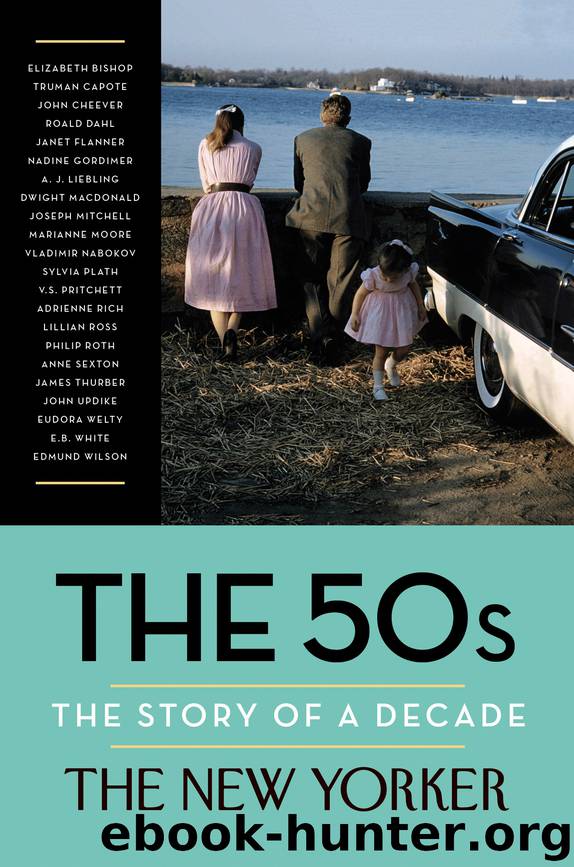The 50s by The New Yorker Magazine

Author:The New Yorker Magazine
Language: eng
Format: epub
Publisher: Random House Publishing Group
Published: 2015-09-29T04:00:00+00:00
A NOTE BY MALCOLM GLADWELL
ISTORY IS WRITTEN by the victors,” Winston Churchill supposedly said, which is a version of the argument that scientists would make a generation later about memory. What we recall, from a given moment or period, is not a videotape of what we actually experienced, pristinely stored in our mental archive. It is a memory overlaid with what we were later told or saw or read, to the point where the initial memory has been revised—often without our realizing it—a thousand times. History is written in the editing room: the victor controls postproduction. Keep that in mind when you read what follows. This is not the 1950s. It is The New Yorker’s 1950s, and the reason you are reading it is that The New Yorker won.
Think about what you know about that decade. Some of you lived through it, but that, the memory experts tell us, has made your recollections all the more subject to post-hoc revision. Many of us were born after it, and for us the problem is much worse. What we do know? Maybe we saw North by Northwest and remember that scene where Cary Grant—or was it Jimmy Stewart?—had his secretary bring him his messages while he went for a martini at the Plaza. People drank a lot in the 1950s—or, at least, Madison Avenue advertising executives did, or at least Madison Avenue advertising executives did as imagined by squat, balding, middle-aged British directors who may never have set foot inside a Madison Avenue agency. My elemental 1950s memory was reading Henry Gregor Felsen’s 1953 teen masterpiece, Street Rod, in rural Canada as a child, which convinced me that, just two decades earlier, the United States was swarming with sixteen-year-olds driving tricked-out roadsters down dusty Midwestern highways at ridiculous speeds. I waited, impatiently, for 1970s Canada to catch up with 1950s America on this particular front. (I’m still waiting.) Felsen, by the way, was the son of Harry and Sabina Felsen of Brooklyn. My vision of the 1950s, in other words, was constructed in southwest Ontario in the 1970s out of the Midwestern fantasies of a Depression-era kid from New York City, whose actual experiences with motorized transport as a seventeen-year-old were probably confined to streetcars and the Q train from Flatbush. We are what we read. It’s probably better that way.
So what do these brief vignettes tells us about The New Yorker’s 1950s? The twenty-one shorts that follow are drawn largely from The Talk of the Town, which establishes the tenor, although some are excerpts from full-scale stories. By design, they give us a magical, crisply imagined decade that takes place on the island of Manhattan, or on the way to Manhattan—as when Lillian Ross catches up with Ernest Hemingway at the baggage claim at Idlewild. This was the fifties: Kennedy was still a senator and not yet an airport. We get an unforgettable portrait of Toots Shor, whose roost—the restaurant Toots Shor’s—was at 51 West Fifty-first Street, eight blocks from the New Yorker offices, on Forty-third.
Download
This site does not store any files on its server. We only index and link to content provided by other sites. Please contact the content providers to delete copyright contents if any and email us, we'll remove relevant links or contents immediately.
Aircraft Design of WWII: A Sketchbook by Lockheed Aircraft Corporation(32219)
The Great Music City by Andrea Baker(31548)
Call Me by Your Name by André Aciman(20380)
The Secret History by Donna Tartt(18865)
The Art of Boudoir Photography: How to Create Stunning Photographs of Women by Christa Meola(18545)
Shoot Sexy by Ryan Armbrust(17663)
Plagued by Fire by Paul Hendrickson(17335)
Portrait Mastery in Black & White: Learn the Signature Style of a Legendary Photographer by Tim Kelly(16957)
Adobe Camera Raw For Digital Photographers Only by Rob Sheppard(16908)
Photographically Speaking: A Deeper Look at Creating Stronger Images (Eva Spring's Library) by David duChemin(16623)
Ready Player One by Cline Ernest(14534)
Pimp by Iceberg Slim(14401)
Bombshells: Glamour Girls of a Lifetime by Sullivan Steve(13981)
The Goal (Off-Campus #4) by Elle Kennedy(13544)
Art Nude Photography Explained: How to Photograph and Understand Great Art Nude Images by Simon Walden(12977)
Kathy Andrews Collection by Kathy Andrews(11738)
The Priory of the Orange Tree by Samantha Shannon(8894)
The remains of the day by Kazuo Ishiguro(8832)
Thirteen Reasons Why by Jay Asher(8802)
